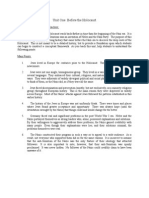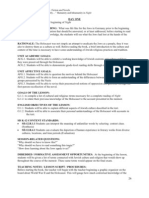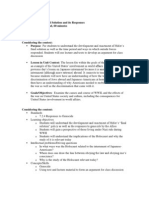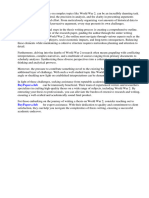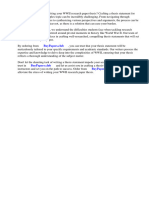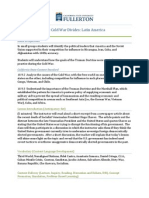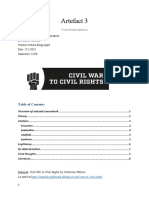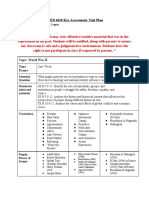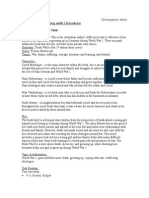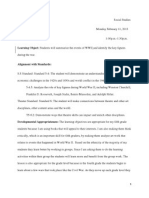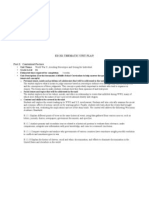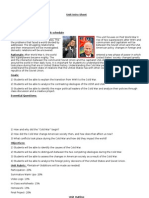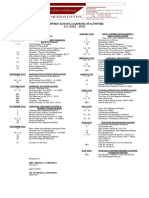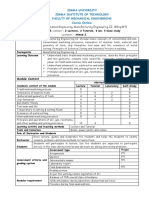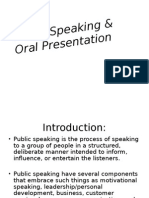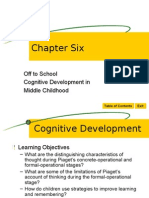Sslessonplan
Sslessonplan
Uploaded by
api-295254879Original Description:
Original Title
Copyright
Available Formats
Share this document
Did you find this document useful?
Is this content inappropriate?
Report this DocumentCopyright:
Available Formats
Sslessonplan
Sslessonplan
Uploaded by
api-295254879Copyright:
Available Formats
Rose Blanche Holocaust/ WWII Lesson
Name: Jonne Miley
Lesson #: 1
Lesson Title: Rose Blanche and The Holocaust
Grade Level/Subject:
5th Grade Social Studies
NCES/CCSS Standard and
Objective (1)
5.H.1.3 Analyze the impact of major conflicts, battles and wars on the
development of our nation through Reconstruction.
5.C.1
Revised Blooms level of
thinking/type of knowledge
(1)
Behavioral Objective (2)
Topic: Holocaust
Understand how increased diversity resulted from migration,
settlement patterns and economic development in the United
States.
Application- students are putting themselves in the shoes of the
victims and creating their own meaningful identity cards.
The students will know more about the Holocaust and be able to
perceive the heaviness of the event. They will write their own
Identification Cards after seeing cards of the Holocaust
survivors, and through their writing they will feel more
connected to history and to the victims.
The Holocaust was a very important, and very sad period of
Objective Rationale (1)
time. It is important for students to know about the history of the
US as well as the world. Though the Holocaust happened in
Germany, it affected nations everywhere, and was what brought
the US into WW2.
Students should have at least heard of the Holocaust and have a
Prerequisite Knowledge and
general idea of the time period and what went on during WWII.
Skills (1)
Key Terms and Vocabulary
List key terms and vocabulary that are important for students to
(1)
be introduced to in this lesson in order to build an understanding
of the knowledge and skills in the lesson.
Content and Strategies
Instructional
Strategies
Everyone
gather
around
the
carpet!
Today
I
will
Focus/Review (prepares
read a historical fiction book to you called Rose
students for the lesson) (2)
Blanche. We know that historical fiction means that it
takes place in an important time period. Just by
looking at the cover, what time period do you think
this book might be about? Ill give you a hint. The
story took place around the 1940s, not necessarily in
America. However, what did happen here affected
countries all over the world, including America, in a
really big way. Turn to first page (images of Nazis)
Now I think we all know what time period this is.
This is a book about the Holocaust, which took place
and essentially started WWII.
Revised for spring, 2012
Objective as stated for
students (helps students set
their own goals for the lesson)
(1)
Teacher Input (provides the
content to students in a
teacher-directed manner) (3)
Today we are going to read a childrens book about the holocaust, then
we are going to learn some background information about the story and
that time period. After that, I have a cool activity planned for you all!
Guided Practice (scaffolded
practice with the content;
helps students make sense of
the content provided in
Teacher Input) (3)
Pass around Identification Cards. Explain that these
are all that we have left of the Holocaust victims,
after their lives were so quickly taken from them. For
the few survivors, their Identification Cards were
their only possession coming out of the camps. Be
sure to emphasize how important these cards were to
these people.
Pass out templates for Identification Cards for the students to make.
Tell them that these cards should include everything they think is
important about them, and what they would want strangers in the future
to know about them. Put on a video about the history of WWII as they
are writing their ID cards.
I hope you all had fun making your IDs; I cant wait to see them! Not
only did we learn a lot about what it was like for the people of that time
period, I think we also learned a lot about how it affected the whole
world. Keep in mind that this book, though very sad, was written in the
perspective of someone outside of the camps. That just goes to show
you how awful that time period was. Hitlers Nazi Germany started out
by negatively affecting the Jews in Germany, then went on to affect
everyone in his nation, and eventually the whole world.
Independent Practice
(application activities to help
students use and demonstrate
what they have learned) (2)
Closure (provides a wrap-up
for the lesson) (1)
Read Rose Blanche to the kids. Point out historical
elements in the illustrations.
p. 1 Does anyone know what this symbol was called
and what it represented? Swastika; Nazi symbol
p. 6 Notice the illustrations of the car. This is the
way cars in America looked in that time period too.
p. 14 This is a really powerful illustration. How does
looking at this picture make you feel?
p. 18 The story says they have bright yellow stars
pinned on their shirts. Does anyone know what those
stars represented and why they had to wear them?
Jewish star of David; to show they were Jewish
p. 24 Here, new soldiers have taken over. It says
they speak another language. We know that the army
must have been one of the allied powers in the war.
World War II involved almost every country in the
world. The war was the allies against the axis powers,
which were Germany, Italy, Japan, Hungary,
Romania, and Bulgaria. The allies included the US,
Britan, France, USSR (Russia), Australia, Belgium,
Brazil, Canada, China, Netherlands, Denmark,
Greece, New Zealand, Norway, Poland, Yugoslavia
and South Africa. Looking at this picture, however,
we can guess that these are Russian soldiers by their
uniforms and the Russian hats on their heads.
Revised for spring, 2012
Evaluation (How will you
assess students learning so
that you can determine if they
met the objective of the
lesson?) (2)
Plans for Individual
Differences (differentiations
needed for students) (1)
Materials used in the lesson;
Resources used in developing
the lesson (1)
21st Century Skills (must be
in three lessons)
Formative:
While reading, I will give the students background information on the
book and ask questions to check for understanding throughout.
Summative:
Students will show empathy and understanding in their writing
assignment.
I should see that they are able to relate to the victims and put themselves
in their shoes, seeing how important these cards are to honoring those
peoples lives.
Their writing should be powerful, and have purpose.
ELLs: This class contains several ELLs, which makes it difficult to
allow the class to read to themselves. This is also the reason why we
will be watching an informational film during ID card crafting. The
children are also slow writers, but thankfully, there are teaching
assistants during this class period to help those individuals with their
assignments.
Child with autism: This student tends to argue with other students, and
with the teacher as well. I will do as the teacher does, and politely
remind him of his job as a student if he tries to tell other students what
to do. I will also be very patient with his questions and try to
accommodate to his needs.
Rose Blanche by Roberto Innocenti, printed Identification Card
examples, printed ID card templates, video on history of WWII
Creativity- Students get to use creativity when writing and illustrating
their Identification cards
Cross Cultural skills- The lesson is focused on German history, and how
events in Germany brought the US and the world to war.
Global Awareness (must be in The book Rose Blanche teaches the kids about the Holocaust which
happened in Germany. During teacher input, I describe how this event
two lessons)
sparked WWII and I list which countries (including the US) were
involved. The informational video they watch (during independent
practice) while writing their identification cards teaches the students
tons of German history and a lot about WWII.
The whole lesson teaches kids to be culturally responsive, because it
Culturally Responsive
shows what horrible things can occur when people are not.
Teaching (must be in three
lessons)
Overall alignment in the lesson (2):
The behavioral objective must be aligned to the lesson objectives (NCES/CCSS).
The instructional activities must help students meet the behavioral objective and be successful on the
lesson assessment.
The lesson assessment must provide enough reliable and valid data so the teacher can determine if
each student has met the lesson objectives or not.
Add any instructional materials needed for the lesson here (worksheets, assessments, PowerPoints,
slides from SmartBoard programs, etc.) (2)
Revised for spring, 2012
You might also like
- World War One Unit PlanDocument17 pagesWorld War One Unit Planplsmith54No ratings yet
- SEI Capstone ProjectDocument21 pagesSEI Capstone ProjectAshley Green100% (5)
- Tgc-Ubd For WwiiDocument6 pagesTgc-Ubd For Wwiiapi-263175247100% (1)
- Delta Module Three Standard and Eltm Options Examination ReportDocument17 pagesDelta Module Three Standard and Eltm Options Examination ReportRamsey MooreNo ratings yet
- Andrew Feller Lesson Plan 4Document4 pagesAndrew Feller Lesson Plan 4api-667216867No ratings yet
- World War II Unit Plan: Minnesota Social Studies StandardDocument12 pagesWorld War II Unit Plan: Minnesota Social Studies StandardSmooth BigmackNo ratings yet
- Ww2 Propaganda ThesisDocument7 pagesWw2 Propaganda Thesistracywilliamssalem100% (2)
- Professional LiteratureDocument6 pagesProfessional Literatureapi-356387598No ratings yet
- Teaching The Holocaust Through PoetryDocument6 pagesTeaching The Holocaust Through Poetrynatalia svirskayaNo ratings yet
- Unit One - Before The HolocaustDocument17 pagesUnit One - Before The Holocaustapi-239586706No ratings yet
- Concept AnalysisDocument19 pagesConcept AnalysisHoang ManhNo ratings yet
- The Rise of Nazi Germany Name: Will Walsh Class/Subject: 8th Grade Social Studies Student Objectives/Student OutcomesDocument5 pagesThe Rise of Nazi Germany Name: Will Walsh Class/Subject: 8th Grade Social Studies Student Objectives/Student OutcomesWilliam WalshNo ratings yet
- We Can Do It WwiiDocument5 pagesWe Can Do It Wwiiapi-252901267No ratings yet
- Felber Final Unit PlanDocument23 pagesFelber Final Unit Planapi-606856347No ratings yet
- Night Lesson PlansDocument19 pagesNight Lesson PlansBard23100% (1)
- Morgan DupDocument3 pagesMorgan Dupapi-385021480No ratings yet
- HIS 356 - The World at WarDocument7 pagesHIS 356 - The World at WaravribkaNo ratings yet
- Cultural Diversity Lesson PlanDocument4 pagesCultural Diversity Lesson Planapi-350281385No ratings yet
- Second World War Dissertation IdeasDocument4 pagesSecond World War Dissertation IdeasWriteMyPsychologyPaperUK100% (1)
- Homework Ww2Document8 pagesHomework Ww2afeuwqxvd100% (1)
- Newsletter 2Document2 pagesNewsletter 2api-317891089No ratings yet
- OriginsColdWar L OneDocument27 pagesOriginsColdWar L OneClaudiu-Valentin StrejaNo ratings yet
- The Wave - LP 1Document4 pagesThe Wave - LP 1api-206642598No ratings yet
- Social Studies Integrated UnitDocument21 pagesSocial Studies Integrated Unitcherylynnicole0% (1)
- Holocaust LessonDocument3 pagesHolocaust LessonCrystal KingNo ratings yet
- Research Paper Outline World War 2Document6 pagesResearch Paper Outline World War 2aflbqewzh100% (1)
- Ww2 Term Paper TopicsDocument5 pagesWw2 Term Paper Topicsafmzwgeabzeksp100% (1)
- Focus: A+ Research PaperDocument15 pagesFocus: A+ Research PapermgskumarNo ratings yet
- Wwii Research Paper ThesisDocument6 pagesWwii Research Paper Thesisafedthktn100% (1)
- Unit Plan End Cold WarDocument29 pagesUnit Plan End Cold WarDaniel Gonzalez NazralaNo ratings yet
- Lesson Plan Unit 5 5 DaysDocument6 pagesLesson Plan Unit 5 5 Daysapi-242796051No ratings yet
- The Holocaust 5-Day SIOP Lesson PlanDocument11 pagesThe Holocaust 5-Day SIOP Lesson PlancherylynnicoleNo ratings yet
- Lesson Plan - The Cold War Divides-Latin AmericaDocument3 pagesLesson Plan - The Cold War Divides-Latin Americaapi-212056067No ratings yet
- Research Paper On World War 2 PropagandaDocument8 pagesResearch Paper On World War 2 Propagandazrpcnkrif100% (1)
- Shannon Quigley ISGAP Syllabus Holocaust and AntisemitismDocument4 pagesShannon Quigley ISGAP Syllabus Holocaust and AntisemitismFrank LiangNo ratings yet
- Julia Giordano in My Hands UnitDocument9 pagesJulia Giordano in My Hands Unitapi-253760877No ratings yet
- World War II Lesson PlanDocument11 pagesWorld War II Lesson Planruss_yonceNo ratings yet
- Text SetDocument11 pagesText Setapi-253723366No ratings yet
- GhostsOfRwanda PDFDocument23 pagesGhostsOfRwanda PDFGherald EdañoNo ratings yet
- Artefact 3 - CoursebookDocument8 pagesArtefact 3 - CoursebookGustav SchrollNo ratings yet
- Digital Unit Plan Template Unit Title: World War II: at Home and Beyond Name: Regina Ang Lee Content Area: History Grade Level: 11Document3 pagesDigital Unit Plan Template Unit Title: World War II: at Home and Beyond Name: Regina Ang Lee Content Area: History Grade Level: 11api-354216325No ratings yet
- Key Assessment 2 - Unit PlanDocument45 pagesKey Assessment 2 - Unit Planapi-643286079No ratings yet
- Journey Box SummaryDocument3 pagesJourney Box Summaryapi-403783822No ratings yet
- CT 748 - Performance ProjectDocument15 pagesCT 748 - Performance Projectapi-248601371No ratings yet
- TwsDocument53 pagesTwsapi-314205938No ratings yet
- Shoah Project CompletedDocument14 pagesShoah Project Completedapi-390946709No ratings yet
- Unit 3 Grade 9Document4 pagesUnit 3 Grade 9api-267136526No ratings yet
- Night Unit PlanDocument3 pagesNight Unit Planapi-259314434No ratings yet
- Learning With LiteratureDocument7 pagesLearning With Literatureapi-295131773No ratings yet
- Good Ww2 Research Paper TopicsDocument4 pagesGood Ww2 Research Paper Topicsnynodok1pup3100% (1)
- UnitplanDocument43 pagesUnitplanapi-270964596No ratings yet
- Digital Unit PlanDocument3 pagesDigital Unit Planapi-268924238No ratings yet
- S S Lesson 1Document10 pagesS S Lesson 1api-185950353No ratings yet
- Ww1 Homework Ideas Ks2Document7 pagesWw1 Homework Ideas Ks2afmtleeon100% (1)
- Ed 321 Thematic Unit PlanDocument20 pagesEd 321 Thematic Unit Planapi-105226197No ratings yet
- Unit Intro Sheet Subject: United States History Grade Level: 12 Unit Four: The Cold War Two Week Unit: 75 Minute Block Schedule OverviewDocument18 pagesUnit Intro Sheet Subject: United States History Grade Level: 12 Unit Four: The Cold War Two Week Unit: 75 Minute Block Schedule Overviewapi-302422961No ratings yet
- Explaining Evil: Vienna and Hitler'S Genocide: K. Simpson NCSA ViennaDocument4 pagesExplaining Evil: Vienna and Hitler'S Genocide: K. Simpson NCSA ViennadeepashajiNo ratings yet
- Dup WwiiDocument2 pagesDup Wwiiapi-361528459No ratings yet
- The Bracelet Read AloudDocument2 pagesThe Bracelet Read Aloudapi-252918385No ratings yet
- S3 WWII AssessmentPlanDocument25 pagesS3 WWII AssessmentPlanmcollisonNo ratings yet
- When Will We Talk About Hitler?: German Students and the Nazi PastFrom EverandWhen Will We Talk About Hitler?: German Students and the Nazi PastNo ratings yet
- French France Ciel SchoolDocument2 pagesFrench France Ciel SchoolnkshinaNo ratings yet
- NEP, 2020 Assessment Reforms: National Council of Educational Research and TrainingDocument19 pagesNEP, 2020 Assessment Reforms: National Council of Educational Research and TrainingMRINMAY KUSHALNo ratings yet
- Aptitude Test For MBA PreparationDocument5 pagesAptitude Test For MBA Preparationjoannmacala100% (1)
- How To Pass The Civil Service Exam in The Philippines in One TakeDocument4 pagesHow To Pass The Civil Service Exam in The Philippines in One TakeP.J. JulianNo ratings yet
- Trainers Slides MistakeproofingDocument15 pagesTrainers Slides MistakeproofingQC-Metinca Prima Industrial WorksNo ratings yet
- FINAL VERSION TrendDocument2 pagesFINAL VERSION TrendHai Ninh HoNo ratings yet
- NTSE Rules For Disbursement of ScholarshipDocument5 pagesNTSE Rules For Disbursement of ScholarshipMota ChashmaNo ratings yet
- English Grammar, Learn English Verbs, Learn English Verb Forms, Verb List, Forms of VerbsDocument4 pagesEnglish Grammar, Learn English Verbs, Learn English Verb Forms, Verb List, Forms of Verbsnikhil_tiwari809No ratings yet
- School Calendar 2022-2023Document1 pageSchool Calendar 2022-2023carrenbridgemejNo ratings yet
- Fear of Negative Evaluation and Social Anxiety in University StudentsDocument9 pagesFear of Negative Evaluation and Social Anxiety in University Studentsnajeeb ullahNo ratings yet
- Course Outline MFG IIDocument2 pagesCourse Outline MFG IIAbrham ChanieNo ratings yet
- IG 1 Year End Examination Booklet 2023Document26 pagesIG 1 Year End Examination Booklet 2023peter.campbellwattsNo ratings yet
- Computer McqsDocument2 pagesComputer McqsAmir ShahzadNo ratings yet
- Research Design Part 3Document34 pagesResearch Design Part 3Joseph MburuNo ratings yet
- Silabus Dan SAP Reading 5Document3 pagesSilabus Dan SAP Reading 5Yadi MuliadiNo ratings yet
- Evaluation Protocol - NRPUDocument7 pagesEvaluation Protocol - NRPUZim ShahNo ratings yet
- Teacher CardDocument4 pagesTeacher CardMUTHYALA NEERAJANo ratings yet
- STD 509 Info ReportDocument2 pagesSTD 509 Info ReportShane CallahanNo ratings yet
- Chapter 11Document3 pagesChapter 11john doeNo ratings yet
- Roll Number Name Date of Birth TCS Reference ID Date of Test Reporting Time Test TimingDocument1 pageRoll Number Name Date of Birth TCS Reference ID Date of Test Reporting Time Test TimingMohd JunedNo ratings yet
- Public Speaking NoteDocument21 pagesPublic Speaking NoteMells MyNo ratings yet
- Computer Adaptive Testing of Listening and Reading SkillsDocument4 pagesComputer Adaptive Testing of Listening and Reading Skillskailu sunNo ratings yet
- BBA SyllabusDocument74 pagesBBA SyllabusShaikat D. AjaxNo ratings yet
- Chapter Six: Off To School Cognitive Development in Middle ChildhoodDocument43 pagesChapter Six: Off To School Cognitive Development in Middle Childhoodfemfen1225No ratings yet
- Essay 1Document6 pagesEssay 1api-340984277No ratings yet
- Assistant Engineer (Electrical) 15!11!2014Document2 pagesAssistant Engineer (Electrical) 15!11!2014Mevin VargheseNo ratings yet
- SESSION PLAN in HousekeepingDocument2 pagesSESSION PLAN in HousekeepingSABRINA ANN MONIONNo ratings yet
- As 91165Document3 pagesAs 91165api-252561013No ratings yet
- Quantitative Vs Qualitative ResearchDocument35 pagesQuantitative Vs Qualitative ResearchPratikshya SahooNo ratings yet









